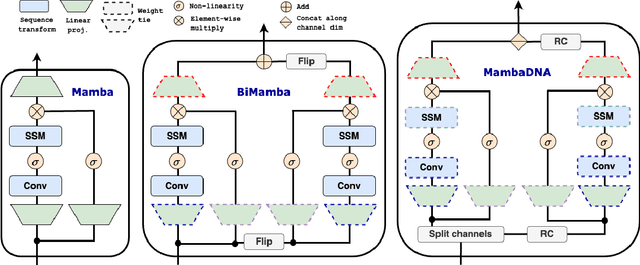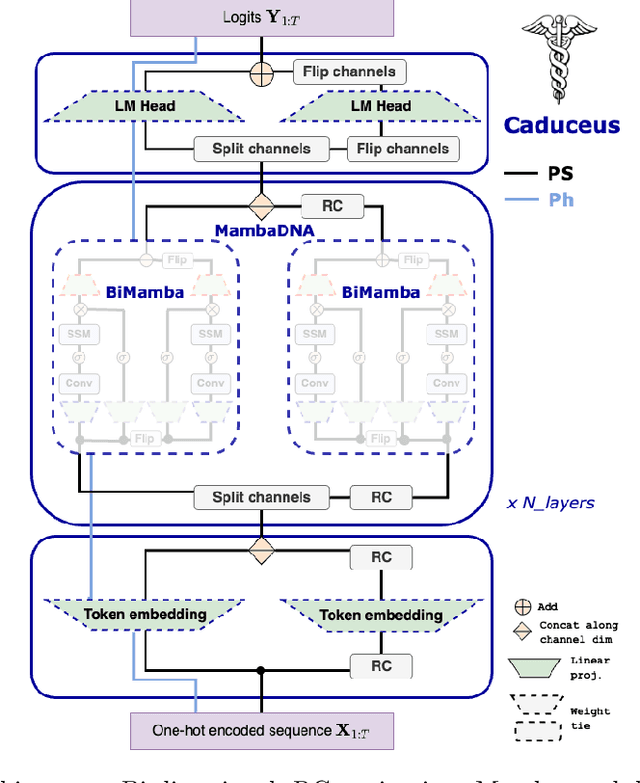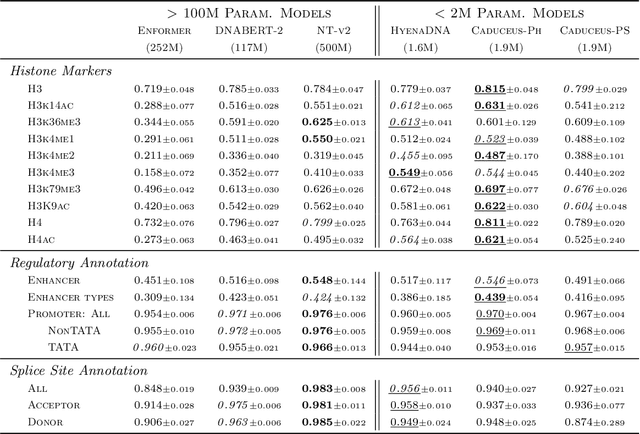Albert Gu
Machine Learning Department, Carnegie Mellon University
Lyra: An Efficient and Expressive Subquadratic Architecture for Modeling Biological Sequences
Mar 20, 2025Abstract:Deep learning architectures such as convolutional neural networks and Transformers have revolutionized biological sequence modeling, with recent advances driven by scaling up foundation and task-specific models. The computational resources and large datasets required, however, limit their applicability in biological contexts. We introduce Lyra, a subquadratic architecture for sequence modeling, grounded in the biological framework of epistasis for understanding sequence-to-function relationships. Mathematically, we demonstrate that state space models efficiently capture global epistatic interactions and combine them with projected gated convolutions for modeling local relationships. We demonstrate that Lyra is performant across over 100 wide-ranging biological tasks, achieving state-of-the-art (SOTA) performance in many key areas, including protein fitness landscape prediction, biophysical property prediction (e.g. disordered protein region functions) peptide engineering applications (e.g. antibody binding, cell-penetrating peptide prediction), RNA structure analysis, RNA function prediction, and CRISPR guide design. It achieves this with orders-of-magnitude improvements in inference speed and reduction in parameters (up to 120,000-fold in our tests) compared to recent biology foundation models. Using Lyra, we were able to train and run every task in this study on two or fewer GPUs in under two hours, democratizing access to biological sequence modeling at SOTA performance, with potential applications to many fields.
Thinking Slow, Fast: Scaling Inference Compute with Distilled Reasoners
Feb 27, 2025Abstract:Recent advancements have demonstrated that the performance of large language models (LLMs) can be significantly enhanced by scaling computational resources at test time. A common strategy involves generating multiple Chain-of-Thought (CoT) trajectories and aggregating their outputs through various selection mechanisms. This raises a fundamental question: can models with lower complexity leverage their superior generation throughput to outperform similarly sized Transformers for a fixed computational budget? To address this question and overcome the lack of strong subquadratic reasoners, we distill pure and hybrid Mamba models from pretrained Transformers. Trained on only 8 billion tokens, our distilled models show strong performance and scaling on mathematical reasoning datasets while being much faster at inference for large batches and long sequences. Despite the zero-shot performance hit due to distillation, both pure and hybrid Mamba models can scale their coverage and accuracy performance past their Transformer teacher models under fixed time budgets, opening a new direction for scaling inference compute.
Llamba: Scaling Distilled Recurrent Models for Efficient Language Processing
Feb 23, 2025Abstract:We introduce Llamba, a family of efficient recurrent language models distilled from Llama-3.x into the Mamba architecture. The series includes Llamba-1B, Llamba-3B, and Llamba-8B, which achieve higher inference throughput and handle significantly larger batch sizes than Transformer-based models while maintaining comparable benchmark performance. Furthermore, Llamba demonstrates the effectiveness of cross-architecture distillation using MOHAWK (Bick et al., 2024), achieving these results with less than 0.1% of the training data typically used for models of similar size. To take full advantage of their efficiency, we provide an optimized implementation of Llamba for resource-constrained devices such as smartphones and edge platforms, offering a practical and memory-efficient alternative to Transformers. Overall, Llamba improves the tradeoff between speed, memory efficiency, and performance, making high-quality language models more accessible.
On the Benefits of Memory for Modeling Time-Dependent PDEs
Sep 03, 2024Abstract:Data-driven techniques have emerged as a promising alternative to traditional numerical methods for solving partial differential equations (PDEs). These techniques frequently offer a better trade-off between computational cost and accuracy for many PDE families of interest. For time-dependent PDEs, existing methodologies typically treat PDEs as Markovian systems, i.e., the evolution of the system only depends on the ``current state'', and not the past states. However, distortion of the input signals -- e.g., due to discretization or low-pass filtering -- can render the evolution of the distorted signals non-Markovian. In this work, motivated by the Mori-Zwanzig theory of model reduction, we investigate the impact of architectures with memory for modeling PDEs: that is, when past states are explicitly used to predict the future. We introduce Memory Neural Operator (MemNO), a network based on the recent SSM architectures and Fourier Neural Operator (FNO). We empirically demonstrate on a variety of PDE families of interest that when the input is given on a low-resolution grid, MemNO significantly outperforms the baselines without memory, achieving more than 6 times less error on unseen PDEs. Via a combination of theory and experiments, we show that the effect of memory is particularly significant when the solution of the PDE has high frequency Fourier components (e.g., low-viscosity fluid dynamics), and it also increases robustness to observation noise.
Transformers to SSMs: Distilling Quadratic Knowledge to Subquadratic Models
Aug 19, 2024



Abstract:Transformer architectures have become a dominant paradigm for domains like language modeling but suffer in many inference settings due to their quadratic-time self-attention. Recently proposed subquadratic architectures, such as Mamba, have shown promise, but have been pretrained with substantially less computational resources than the strongest Transformer models. In this work, we present a method that is able to distill a pretrained Transformer architecture into alternative architectures such as state space models (SSMs). The key idea to our approach is that we can view both Transformers and SSMs as applying different forms of mixing matrices over the token sequences. We can thus progressively distill the Transformer architecture by matching different degrees of granularity in the SSM: first matching the mixing matrices themselves, then the hidden units at each block, and finally the end-to-end predictions. Our method, called MOHAWK, is able to distill a Mamba-2 variant based on the Phi-1.5 architecture (Phi-Mamba) using only 3B tokens and a hybrid version (Hybrid Phi-Mamba) using 5B tokens. Despite using less than 1% of the training data typically used to train models from scratch, Phi-Mamba boasts substantially stronger performance compared to all past open-source non-Transformer models. MOHAWK allows models like SSMs to leverage computational resources invested in training Transformer-based architectures, highlighting a new avenue for building such models.
Hydra: Bidirectional State Space Models Through Generalized Matrix Mixers
Jul 13, 2024Abstract:A wide array of sequence models are built on a framework modeled after Transformers, comprising alternating sequence mixer and channel mixer layers. This paper studies a unifying matrix mixer view of sequence mixers that can be conceptualized as a linear map on the input sequence. This framework encompasses a broad range of well-known sequence models, including the self-attention of Transformers as well as recent strong alternatives such as structured state space models (SSMs), and allows understanding downstream characteristics such as efficiency and expressivity through properties of their structured matrix class. We identify a key axis of matrix parameterizations termed sequence alignment, which increases the flexibility and performance of matrix mixers, providing insights into the strong performance of Transformers and recent SSMs such as Mamba. Furthermore, the matrix mixer framework offers a systematic approach to developing sequence mixers with desired properties, allowing us to develop several new sub-quadratic sequence models. In particular, we propose a natural bidirectional extension of the Mamba model (Hydra), parameterized as a quasiseparable matrix mixer, which demonstrates superior performance over other sequence models including Transformers on non-causal tasks. As a drop-in replacement for attention layers, Hydra outperforms BERT by 0.8 points on the GLUE benchmark and ViT by 2% Top-1 accuracy on ImageNet.
An Empirical Study of Mamba-based Language Models
Jun 12, 2024



Abstract:Selective state-space models (SSMs) like Mamba overcome some of the shortcomings of Transformers, such as quadratic computational complexity with sequence length and large inference-time memory requirements from the key-value cache. Moreover, recent studies have shown that SSMs can match or exceed the language modeling capabilities of Transformers, making them an attractive alternative. In a controlled setting (e.g., same data), however, studies so far have only presented small scale experiments comparing SSMs to Transformers. To understand the strengths and weaknesses of these architectures at larger scales, we present a direct comparison between 8B-parameter Mamba, Mamba-2, and Transformer models trained on the same datasets of up to 3.5T tokens. We also compare these models to a hybrid architecture consisting of 43% Mamba-2, 7% attention, and 50% MLP layers (Mamba-2-Hybrid). Using a diverse set of tasks, we answer the question of whether Mamba models can match Transformers at larger training budgets. Our results show that while pure SSMs match or exceed Transformers on many tasks, they lag behind Transformers on tasks which require strong copying or in-context learning abilities (e.g., 5-shot MMLU, Phonebook) or long-context reasoning. In contrast, we find that the 8B Mamba-2-Hybrid exceeds the 8B Transformer on all 12 standard tasks we evaluated (+2.65 points on average) and is predicted to be up to 8x faster when generating tokens at inference time. To validate long-context capabilities, we provide additional experiments evaluating variants of the Mamba-2-Hybrid and Transformer extended to support 16K, 32K, and 128K sequences. On an additional 23 long-context tasks, the hybrid model continues to closely match or exceed the Transformer on average. To enable further study, we release the checkpoints as well as the code used to train our models as part of NVIDIA's Megatron-LM project.
Transformers are SSMs: Generalized Models and Efficient Algorithms Through Structured State Space Duality
May 31, 2024Abstract:While Transformers have been the main architecture behind deep learning's success in language modeling, state-space models (SSMs) such as Mamba have recently been shown to match or outperform Transformers at small to medium scale. We show that these families of models are actually quite closely related, and develop a rich framework of theoretical connections between SSMs and variants of attention, connected through various decompositions of a well-studied class of structured semiseparable matrices. Our state space duality (SSD) framework allows us to design a new architecture (Mamba-2) whose core layer is an a refinement of Mamba's selective SSM that is 2-8X faster, while continuing to be competitive with Transformers on language modeling.
Caduceus: Bi-Directional Equivariant Long-Range DNA Sequence Modeling
Mar 05, 2024



Abstract:Large-scale sequence modeling has sparked rapid advances that now extend into biology and genomics. However, modeling genomic sequences introduces challenges such as the need to model long-range token interactions, the effects of upstream and downstream regions of the genome, and the reverse complementarity (RC) of DNA. Here, we propose an architecture motivated by these challenges that builds off the long-range Mamba block, and extends it to a BiMamba component that supports bi-directionality, and to a MambaDNA block that additionally supports RC equivariance. We use MambaDNA as the basis of Caduceus, the first family of RC equivariant bi-directional long-range DNA language models, and we introduce pre-training and fine-tuning strategies that yield Caduceus DNA foundation models. Caduceus outperforms previous long-range models on downstream benchmarks; on a challenging long-range variant effect prediction task, Caduceus exceeds the performance of 10x larger models that do not leverage bi-directionality or equivariance.
Griffin: Mixing Gated Linear Recurrences with Local Attention for Efficient Language Models
Feb 29, 2024Abstract:Recurrent neural networks (RNNs) have fast inference and scale efficiently on long sequences, but they are difficult to train and hard to scale. We propose Hawk, an RNN with gated linear recurrences, and Griffin, a hybrid model that mixes gated linear recurrences with local attention. Hawk exceeds the reported performance of Mamba on downstream tasks, while Griffin matches the performance of Llama-2 despite being trained on over 6 times fewer tokens. We also show that Griffin can extrapolate on sequences significantly longer than those seen during training. Our models match the hardware efficiency of Transformers during training, and during inference they have lower latency and significantly higher throughput. We scale Griffin up to 14B parameters, and explain how to shard our models for efficient distributed training.
 Add to Chrome
Add to Chrome Add to Firefox
Add to Firefox Add to Edge
Add to Edge